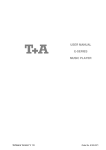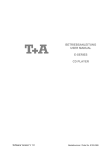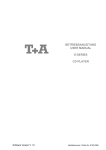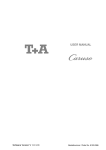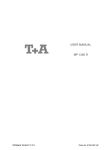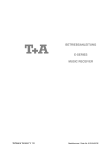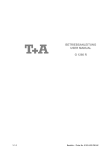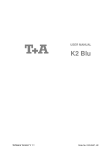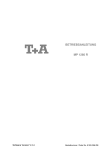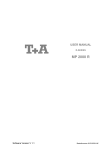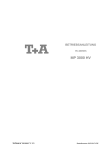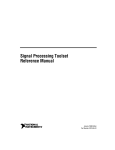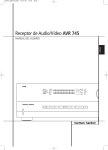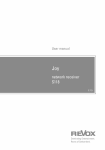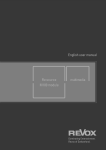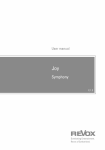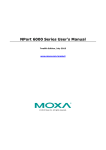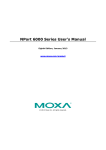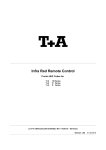Download USER MANUAL E-SERIES MUSIC RECEIVER
Transcript
USER MANUAL
E-SERIES
MUSIC RECEIVER
Software Version V 2.6
Order No. 9103-0453 UK
Welcome.
We are delighted that you have decided to purchase a product. With your new Music Receiver you have acquired
a top-quality piece of equipment which has been designed and developed with the wishes of the audiophile music lover
as absolute top priority.
This system represents our very best efforts at designing practical electronic equipment incorporating solid quality, userfriendly operation and a specification and performance which leaves nothing to be desired.
All these factors contribute to a piece of equipment which will satisfy your highest demands and your most searching
requirements for a period of many years. All the components we use meet the German and European safety norms and
standards which are currently valid. All the materials we use are subject to painstaking quality monitoring.
At all stages of production we avoid the use of substances which are environmentally unsound or potentially hazardous
to health, such as chlorine-based cleaning agents and CFCs.
We also aim to avoid the use of plastics in general, and PVC in particular, in the design of our products. Instead we rely
upon metals and other non-hazardous materials; metal components are ideal for recycling, and also provide effective
electrical screening.
Our robust all-metal cases exclude any possibility of external sources of interference affecting the quality of
reproduction. From the opposite point of view our products’ electro-magnetic radiation (electro-smog) is reduced to an
absolute minimum by the outstandingly effective screening provided by the metal case.
We would like to take this opportunity to thank you for the faith you have shown in our company by purchasing this product, and wish you many hours of enjoyment and sheer listening pleasure with your Music Receiver.
elektroakustik GmbH & Co KG
"iPod is a trademark of Apple Inc., registered in the U.S. and other countries."
All the components we use meet the European safety norms and standards which are currently valid. The operation instructions, the connection guidance and the safety notes are for your own good - please read them
carefully and observe them at all times.
This product complies with the Low Voltage Directive (73/23/EEC), EMV Directives (89/336/EEC, 92/31/EEC) and CE
Marking Directive (93/68/EEC).
IMPORTANT!
CAUTION!
This product contains a laser diode of higher class than 1. To ensure continued safety, do not remove any covers or
attempt to gain access to the inside of the product.
Refer all servicing to qualified personnel.
The following caution label appear on your device:
Rear Panel:
CLASS 1
LASER PRODUCT
On the CD mechanism
CAUTION:
VORSICHT:
ATTENTION:
DANGER:
2
VISIBLE AND INVISIBLE LASER RADIATION WHEN OPEN.
AVOID EXPOSURE TO BEAM
SICHTBARE UND UNSICHTBARE LASERSTRAHLUNG,
WENN ABDECKUNG GEÖFFNET NICHT DEM STRAHL AUSSETZEN
RAYONNEMENT LASER VISIBLE ET INVISIBLE EN CAS
D'OUVERTURE EXPOSITION DANGEREUSE AU FAISCEAU
VISIBLE AND INVISIBLE LASER RADIATION WHEN OPEN.
AVOID DIRECT EXPOSURE TO BEAM
Contents
Operation
Front panel controls ........................................................................................................ 4
Remote Control ............................................................................................................. 7
Basic settings of the Music Receiver ......................................................................... 9
System Settings (System Configuration menu) .............................................................. 9
Tone control settings ..................................................................................................... 12
Recording with the Music Receiver .................................................................. 13
The Music Receiver as a D/A Converter ..................................................................... 13
Operating the tuner ..................................................................................................... 14
Operating the CD player ............................................................................................. 16
Playback Program ......................................................................................................... 17
Operating the Streaming Client ................................................................................. 18
Access to Media Content via the Main Menu (Home Menu) ......................................... 21
Accessing Media Content using the Favourites List ...................................................... 22
Using the system for the first time
Back panel connections ................................................................................................. 24
Installation and wiring .................................................................................................... 26
Safety notes ................................................................................................................... 28
FCC Information to the user .......................................................................................... 29
Network Configuration ................................................................................................ 30
The vTuner Premium Service ..................................................................................... 35
FD 100 radio remote control (optional) ........................................................................ 37
General
Trouble-shooting ............................................................................................................ 38
Glossary / Supplementary Information .......................................................................... 42
Network Terms .............................................................................................................. 44
Maintenance ................................................................................................................... 46
Software update ............................................................................................................. 46
Appendix
Wiring diagram .............................................................................................................. 48
Specification .................................................................................................................. 50
About these instructions
All the controls and functions of the Music Receiver which are frequently used are described in the first section of these
operating instructions.
The second part - 'Basic settings, Installation, Using the system for the first time' covers connections and settings
which are very seldom required; they are generally required only when the machine is set up and used for the first time.
Here you will also find a detailed description of the network settings required for connecting the Music Receiver to your
home network.
Symbols used in these instructions
Caution!
Text passages marked with this symbol contain important information which must be observed if the
machine is to operate safely and without problems.
symbol marks text passages which provide supplementary notes and background information; they
This
are intended to help the user understand how to get the best out of the machine.
italic
Technical terms printed in italics are explained in detail at the end of the instructions.
3
Front panel controls
All the important functions of the Music Receiver can be operated using the buttons on the front panel. Direct-acting
buttons are provided for fundamental functions such as source select, station change and track select. Functions not
needed so frequently are controlled using the menus which are called up using the / / button.
All information relating to the machine’s state, the current track and the associated transmitting station are displayed on
the integral screen; the essential information is displayed in enlarged form in a context-sensitive manner in the main line
of the screen, and is therefore easily legible even from some distance away. The following section explains the functions
of the buttons on the machine, and the information provided on the screen.
(On / Off switch)
A brief press on the button switches the unit on and off. When the
machine is switched on, the indicator light above the button glows.
Caution!
The mains button is not a mains isolation switch. Even when the LED is
not glowing, some parts of the machine are still connected to mains
voltage.
If the machine is not to be used for a long period, we recommend that you
turn it off using the mains switch located on the back panel.
If you switch off using the mains switch the current drain is 0 Watt.
However, in this state the device cannot be switched on again using the
remote control handset. When you wish to switch it on again, first move
the mains switch to the ‘1’ position.
If you wish to disconnect the machine completely from the mains supply,
withdraw the mains plug at the wall socket.
Socket for stereo headphones with an impedance of at least 32 Ω.
(Phones / headphone)
use of headphones
The
Continuous listening to programme material via earphones or head-phones at
very high volume can result in permanent hearing loss. You can avoid damaging
your health by not listening via headphones or ear-phones at high levels for long
periods.
CD drawer
CD drawer is located below the display. Please insert the disc with the
The
label side facing upwards into the appropriate depression of the tray.
4
The drawer is opened and closed by pressing the button.
Selects the CD-Player or the Streaming Client function of the Music Receiver
(Internet radio, access to music server, iPod playback)
Brief press:
Selects the CD player
Long press:
Selects the Streaming Client function
Selects the FM tuner or the device connected to the REC input of the
Music Receiver (recorder)
Brief press:
Selects the FM tuner
Long press:
Selects the REC input
/
A brief press on one of these buttons selects the analogue or the
digital input you wish to use. Press the button repeatedly until the
desired input is displayed on the screen.
wish to make the selection process easier, you can remove from the select
Iflistyouthose
sources which are not used in your system. See chapter ‘System
configuration menu / Source names’.
Source menu
Opens the Setup menu for the source device just selected
System menu
Opens the ‘System configuration’ menu
(for details see Chapter ‘System settings’)
Brief press:
Opens the tone control settings menu
Long press:
When SCL (Streaming Client) is selected as source:
Switching between the USB inputs USB 1 (HDD) and
USB 2 (iPod).
It is only possible to switch inputs in the top menu level of the
SCL (main menu).
Navigation
Back to the previous point / change button
Confirms input / change button
Selects the next point within a list / select button
Selects the previous point within a list / select button
Confirm button
Ends playback
Starts playback / halts playback (pause) / resumes playback after a pause
Superimposing information
Brief press:
Toggle switch between display of current music track and list
navigation
Long press:
Switches between different screen displays
Calls up the Favourites list
/
Brief press:
Long press:
Selects the previous / next track or piece during playback.
Selects the next station in the favourite list
Fast forward / rewind: searches for a particular passage.
Tuner: Search
Button for switching ON and OFF the loudspeaker output.
/
Increase / decrease volume
The volume can be increased / decreased in steps by tipping one of the volume
buttons. The current volume level is displayed on the display screen. If one of
the buttons is kept pressed for approx.. 2 seconds the volume increases /
decreases continuously until the button is released.
To prevent damage to the speakers the volume control stops at volume level
64. To adjust to higher levels, please press the button again. Now you
can adjust to levels up to maximum.
5
All the Music Receiver’s display elements are grouped together in a clearly
arranged screen area.
If the screen displays the message “PROTECTION“ or “OVERHEAT“, the
protection circuit has switched off the speaker-outputs. For details see chapter
“Trouble shooting”.
Display
Protection
Overheat
Source display
The screen displays and symbols vary according to the currently active function
(disc player, SCL, radio, external sources) and the type of music being played.
The basic sub-divisions of the screen:
•
Screen area (a) displays information relating to the current piece of music.
The essential information is displayed in the main line in enlarged form.
•
The bottom line (c) displays additional information and context-sensitive
operating information.
Symbol
Meaning
This symbol indicates that it is possible to switch to a
higher menu level or select menu using the button.
Indicates that the selected menu point / list point can be
activated by pressing the button.
0/0
iPod
Position indicator in Select lists. The first figure indicates
the current position in the list, the second figure the total
number of list entries (list length).
oder
Indicates which USB socket is selected
HDD
Music Receiver provides different screen displays for the Streaming Client
The
and the radio.
• Large-format display:
Enlarged display of the most important information, clearly legible even from
a distance
•
Detail display:
Small-text display showing a large number of additional information points,
e.g. bit-rate etc.
A long press on the button on the remote control handset is used to
switch between the display modes.
6
Remote Control
General Information
All the Music Receiver’s mechanism control functions and auxiliary functions
can be operated using the remote control system.
In general terms the remote control buttons have the same function as the
corresponding buttons on the Music Receiver’s front panel.
The infra-red sensor for the remote control system is located in the display area of
the Music Receiver. There must be clear line-of-sight contact between the
FM100 handset and the screen.
The following tables show the remote control buttons and their functions when
operating the machine.
Switches the Music Receiver on and off
(red)
Direct source select buttons. If the integrated amplifier is switched
off, these buttons switch it on and simultaneously select the
corresponding source device.
Music Receiver’s Streaming Client function
(Internet Radio, access to music server, iPod playback)
Music Receiver’s CD function
Brief press:
Brief press:
Brief press:
A brief press on this button selects the
analogue input you wish to use. Press the
button repeatedly until the desired input is
displayed on the screen.
A brief press on this button selects the digital
input you wish to use. Press the button
repeatedly until the desired input is displayed
on the screen.
Music Receiver’s Radio function
Selects the REC input of the Music Receiver.
abc
...
xyz
Direct alpha-numeric input, e.g. track number, fast station
select, radio station.
The and buttons are also used for non-standard
characters.
During text input you can switch between numeric and alphanumeric input, and between capitals and lower case by pressing
the button.
Switches sound on and off (MUTING)
(yellow)
- + Reduces / increases volume (volume control rocker)
(yellow)
Performs the same function as the corresponding buttons on the
Music Receiver’s front panel.
In Stand-alone mode: sound settings
A brief press opens a menu offering the following set-up
facilities, which vary according to the selected source:
Balance / Treble / Bass / Loudness / Bandwidth / Oversampling
The menu points are called up using the / buttons,
and can be changed using the / buttons.
7
Tuner
CD-Player
Navigation
Streaming Client
Navigation
Back to previous point
Rewind to search for a particular Back to previous point
passage
During alpha-numeric character input you can erase a character with the button.
Confirms input
Fast-forward to search for a
particular passage
- Opens a folder
- Starts a piece of music
- Selects an Internet radio station
Selects the previous point within
a list
Selects the next track during
playback
Selects the previous point within
a list
Selects the next point within a list Selects the previous track during
Selects the next point within a list
Opens a folder
Starts a piece of music
playback
Confirm buttons during input process
Chapter select / Track select / Search / Manual tuning
Selects the previous station in
Selects the previous track during
playback
Selects the previous piece in the
playback list
Brief press: Manual tuning
Rewind to search for a particular
passage
Hold button pressed in for rewind
Long press: Search
Brief press: Manual tuning
Long press: Search
Fast-forward to search for a
particular passage
Hold button pressed in for fast
forward
Selects the next station in the
favourite list.
Selects the next track during
playback
Selects the next piece in the
playback list
Repeat function
Repeat functions
(not possible with all media)
Brief press:
Repeat Track, Repeat ALL,
'Normal'
Long press:
Mix-Mode (Shuffle) ON / OFF
Brief button presses in MIX
mode:
Mix, Repeat Track, Reapeat Mix
the favourite list.
(REPEAT)
(see Chapter 'Operating the CD
player')
Brief press:
Halts playback
Long press:
Opens and closes the CD draw
Select station from Favourites list • Starts playback (Play function)
• During playback: halts (Pause)
(PLAY/
or resumes playback
PAUSE)
Ends playback
(STOP)
8
• Starts playback (Play function)
• During playback: halts (Pause)
or resumes playback
Tuner
CD-Player
Streaming Client
Opens the System Configuration menu (e.g. for adjusting screen brightness)
Opens the Favourites menu
Brief press:
Switches to main menu (Home)
Long press:
Opens the network configuration
menu
when the Favourites list is
displayed.
Long press:
(red)
Removes a favourite from the
station list
Long press:
Erases playback program
Adds a favourite to the station list Activates playback programming
(green)
Adds a track to the playback
program during playback
programming
Adds a favourite to the
Favourites list created on the
Music Receiver
the main menu is displayed:
Toggle switch between inputs
USB 1 and USB 2
Button for switching between
(yellow)
Long press:
Removes a favourite from the
Favourites list created on the
Music Receiver
Stereo and Mono reception
The Stereo setting is constantly
displayed in the screen window
by a symbol.
The Mono setting is constantly
displayed in the screen window
symbol.
by a
During character input:
Switches between numeric and
alpha-numeric input, and
between capitals and lower case
when pressed (repeatedly)
In lists:
Search function (Alpha search)
(blue)
Displays the Favourites list
Displays the Favourites list
created on the Music Receiver
Store button for fast station
Store button for fast station
select
select
Switch CD-Text ON/OFF
Toggles the display between the
‚Now Playing‘ view and track list /
station list navigation.
Switches Radio-text ON/OFF
FD 100 bi-directional
radio remote control
The FD 100, a graphic radio remote control handset with integral colour screen,
is designed to make the Music Receiver even more convenient to operate,
and is available as part of the accessory range. (see chapter ‘FD 100
radio remote control’)
The Music Receiver can be controlled by the App 'TA Control' too.
For further information please visit our homepage
www.ta-hifi.com/app
9
Basic settings of the Music Receiver
System Settings (System Configuration menu)
In the System Configuration menu general device settings are adjusted. This menu is described in detail in the following
chapter.
• Briefly press the button on the front panel or on the remote control
Calling up and operating
the menu
handset to call up the menu.
• When you open the menu, the following Select points appear on the screen:
• Use the / buttons to select a point in the menu.
• If you wish to change a selected menu point, first press the button,
and then use the / buttons to alter it.
• After making the change, press the button again to accept the
new setting.
• You can press the button at any time to interrupt the process; the
change is then abandoned.
• Press the button again to leave the menu.
At this menu point you can activate and disable external sources, and assign a
plain text name to each source; this name then appears in the screen displays.
When you call up this menu point using the button, a list of all the
external sources of the Music Receiver appears. Each source is followed by
the assigned name, or if you have disabled the source concerned the note
'disabled'.
If you want to activate / disable a source, or change the plain text name,
navigate to the appropriate line.
To activate a source, press the green button; pressing the red button disables
the source.
To change the plain text name, press the button once more. Change
the name as you wish, then press to confirm your choice. This action
stores the settings for the source.
Source names
menu point
10
When you call up Source Select using / on the remote control
handset or the source button / on the front panel, any disabled
sources are suppressed. This makes it easier to select sources, and we
recommend that you disable any sources not in use.
Speakersize
menu point
Loudspeaker
Sets the size and bass response of the loudspeaker
SATELLITE
for very small loudspeakers (satellite speakers) with limited bass response.
The low-frequency bass signals (below 100 Hz) of the main channels are mixed
onto the subwoofer. If you are using SAT speakers a sub-woofer is a basic
necessity, otherwise bass response will be inadequate.
FULL-RANGE
for larger speakers.
The full, unrestricted range of frequencies is reproduced via the main channels.
If your system includes full-range speakers, no subwoofer is required.
However, under certain circumstances the use of a large, high-power
subwoofer may still be sensible in order to relieve the strain on the main
loudspeakers during loud passages, and passages with extreme low-frequency
content.
PreOut Mode
menu point
The preamp outputs (PreOut) can either switched ON and OFF together with
the speaker outputs or they can be set to be permanently ON.
The „permanent ON“ setting can be useful for example to supply audio signals
to an other room independently from the speaker state in the main room.
"Linked"
This setting enables the PreOut muting synchronously with the speaker
outputs. Switching ON/OFF all outputs is achieved by pressing the button (Mute).
"perm On"
This setting sets the PreOut outputs to be permantly switched ON.
Brightness
menu point
(screen brightness)
At this point you can adjust the brightness of the integral screen to suit your
per-sonal preference for normal use; seven levels are available.
Language
menu point
In this menu point you define the language to be used for the displays on the
screen of the front panel of the Music Receiver.
The language used for data transferred to the machine, e.g. from an iPod or
other Internet radio station, is determined by the supplying device or the radio
station; you cannot define the language on the Music Receiver.
11
Tone control settings
(Tone menu)
FM100
Music
Receiver
The Music Receiver features a range of facilities for fine-tuning the sound to
suit your personal preference, the listening environment and the particular
recording currently being played. All the tone control settings are grouped in
the TONE menu.
Briefly press the button on the remote control handset to call up the
balance and tone control functions. This action brings up a set-up window
which displays the various adjustment options.
brief press
• Use the / buttons to select an adjustment option.
• The option displayed can now be changed using the /
buttons.
• If no action is taken for a period of a few seconds, the set-up window
disappears from the screen.
Balance L/R
This menu point is used to alter the balance in level between the left and right
channels, e.g. to compensate for non-symmetrical loudspeaker positioning.
The balance can be adjusted in increments of 1,25 dB; the screen always
displays the current value.
The primary purpose of the Balance setting in the Tone menu is to compensate
for inadequacies in the audio mix of the recording currently being played.
Tone Control
This menu point can be used to disable (by-pass) the Music Receiver`s tone
controls.
To switch off the tone controls, select the “OFF” setting. When the tone
controls are switched off, any adjustments you make to the following menu
points “BASS” and “TREBLE” have no effect.
Bass / Treble (tone settings)
These two menu points can be used to alter the high-frequency (treble) and
low-frequency (bass) settings when required.
The primary purpose of the settings in the Tone menu is to compensate for
inadequacies in the audio mix of the recording currently being played.
If you wish to alter the fundamental tone settings for your loudspeakers, you
should make adjustments in the “Loudspeaker / Tone” menu.
Loudness
The Music Receiver is equipped with an automatic level-dependent volume
control system (LOUDNESS), designed to compensate for the frequencydependent sen-sitivity of the ear at very low volume, caused by the physiology
of the human auditory system.
This set-up option switches the level-dependent volume control on and off.
12
Oversampling
A number of special settings are available for the Music Receiver’s D/A
converter; they are designed to fine-tune the characteristics of your amplifier to
suit your listening preferences.
The Music Receiver can exploit two different filter types offering different tonal
characters:
Oversampling 1 is a classic FIR filter with an extremely linear frequency
response (FIR long).
Oversampling 2 is a peak-optimised filter – superb in 'timing' and dynamics
(FIR short).
Please refer to the Chapter 'Glossary / Supplementary Information, Digital
Filter' for an explanation of the different filter types.
Recording with the Music Receiver
To create a recording with a recorder connected to the Music Receiver’s tape
connections (REC) first you have to select the recording source by pressing the
appropriate source button e.g. . After that start the recording function of
your recording-device.
If your recorder is equipped with a monitor function you can monitor the
recording by pressing the button on the remote control or by a long
button press on the button on the front panel. By doing so the recording
source remains unchanged but the listening source will be switched over to the
recorders monitor output so that you can instantly monitor the recording in
progress.
recording the volume level of the Music Receiver should not be
While
increased to values higher than 64. If this value is exceeded the level at the
record-output will change.
The Music Receiver as a D/A Converter
General Information on
D/A Converter Operation
The Music Receiver can be used as a high-quality D/A converter for
other devices such as satellite receiver, digital radio etc. which are fitted with
poor-quality converters or no converter at all. The Music Receiver features five
digital inputs on the back panel to allow this usage.
Devices with an electrical co-axial output or an optical light-pipe output can be
connected to the digital inputs of the Music Receiver. The Music Receiver
accepts digital stereo signals conforming to the S/P-DIF norm with sampling
rates of 32 to 96 kSps at the optical TOS-Link inputs and 32 - 192 kSps at the
coaxial SP/DIF inputs.
D/A Converter Operation
Selecting a
D/A Converter Source
Now repeatedly press the button on the front panel, or press the
button on the remote control handset, to select the digital input to which you
have already connected the source device which is to be played.
As soon as the source device delivers digital music data, the Music Receiver
automatically adjusts itself to the format and sampling rate of the signal, and
you will hear the music.
Screen Display
During D/A converter operations the Music Receiver’s integral screen displays
the characteristics of the digital input signal.
13
Operating the Tuner
First press the button to select the integral tuner as the source.
When you select a station, the integral screen initially shows the reception
frequency or the RDS station name.
Front panel display
The screen on the front panel displays all information in a clear form.
Field strength display:
a) When you are listening to a radio station in Tuner mode, the message
'Radio' appears in the top line of the screen.
b) Here the music type or style is displayed, e.g. Pop Music.
This information is only displayed if the transmitting station broadcasts it as
part of the RDS system. If you are listening to a station which does not
support the RDS system, or only supports it in part, these information fields
remain empty.
c) The frequency and / or the station name is displayed in enlarged form. If a
station name is displayed, its frequency is shown at the end of the line.
d) These lines display information which is broadcast by the station (e.g.
Radiotext).
e) The field strength and therefore the reception quality to be expected from
the set transmitting station can be assessed from the field strength.
f) Display of Stereo '
' / Mono' '
Selecting a station using the Favourites list:
a) The selected station is displayed in enlarged form, and can be called up
using the / / button.
b) Press the button to return to the station previously selected.
c) Position display in the Favourites list.
d) Press the / / button to select the station displayed
in enlarged form.
Station Search
Holding one of the / buttons pressed in initiates a station
search in the upward or downward direction. The station search stops
automatically at the next station.
Favourites List and
Presets
In addition to manual tuning and searching, the tuner of the Music Receiver
also features a Favourites list and Presets, which provide a fast, convenient
method of managing your preferred stations and calling them up at any time.
You can edit the Favourites list to suit your preferences (see section 'Adding
stations to the Favourites list / Erasing stations from the Favourites list').
It is also possible to store the stations under a station number (Preset), and
then to call it up directly by entering the station number. Presets are particularly
useful if you wish to call up stations when the screen is not in sight (e.g. from
an adjacent room), or via the domestic control system.
14
The Favourites List
Creating the Favourites list
When you have called up the Favourites list by pressing the button,
you can press the button to call up the Favourites menu, from which
the following points can be selected using the / buttons:
Sort function
Select the menu point 'Scan for stations' and initiate the station search with
the button. The screen displays the message 'Auto Store active', and
the Music Receiver now automatically stores up to sixty receivable stations in
the Favourites list.
The Favourites list can be sorted according to various criteria; these are
selected in the menu point 'Sort Favourites by':
Frequency / Station name / Program ID
Now use the / buttons to select the desired sort criterion, and
confirm your choice by pressing the button.
Selecting radio stations
from the Favourites list
• Call up the Favourites list with the button, select a stored station from
the Favourites list using the / buttons, and confirm your
choice with the / / button.
• You can also select stations directly, without calling up the Favourites list as
described above, by briefly pressing the / buttons.
Adding stations to the
Favourites list
First set the desired station manually (by briefly pressing the /
buttons) or using a search (holding the / buttons pressed in).
As soon as the station is audible, you can add it to your Favourites list by
pressing the button.
Erasing stations from the
Favourites list
Open the Favourites list. Select the station you wish to erase from the list, hold
the red button pressed in for a few seconds: the station is now removed
from the Favourites list. After the erasure the tuner automatically switches to
the next station in the Favourites list.
Presets
Calling up a Preset
Storing a Preset
At any time you can quickly call up a station stored as a Preset by entering its
Preset number using the F100’s numeric buttons to .
• Select a station, either using the / buttons, or from the
Favourites list.
• Call up the Store Preset function by pressing the button.
• An input window now appears in which you can enter a number using the
numeric buttons (
to ). The Preset is stored when you press a
numeric button. The front panel screen briefly displays the message 'Preset
Stored at' to confirm this.
RDS functions
If the station being received is broadcasting relevant RDS data, the following
information will be displayed on the screen:
• Station name
• Radiotext
• Programm type (genre)
Mono / Stereo
You can toggle the tuner of the Music Receiver between stereo and mono
reception by briefly pressing the button. The reception mode is shown
on the screen by the following symbols:
' ' (Mono) or '
' (Stereo):
If the station you wish to listen to is very weak or very distant, and can only be
picked up with severe background noise, you should always switch to MONO
mode as this reduces the unwanted hiss significantly.
When you store the station in the Favourites list, the settings you enter for this
station are also stored, and are automatically restored the next time you call up
the station.
15
Operating the CD player
Inserting a CD
• Open the CD drawer (
on the front panel / FM100)
• Place the disc centrally in the appropriate depression in the drawer, with the
side to be played facing down.
• Close the CD drawer (
on the front panel / FM100)
When you close the drawer, the machine immediately reads the CD’s 'Table of
Contents'; the screen displays the message 'Reading'. During this period all
button-presses are ignored.
The screen then displays the total number of tracks on the CD in the drawer,
e.g.: '13 Tracks 60:27'.
It is also shows the current mode of operation, e.g.
Playing a CD
Press the button on the front panel or on the FM100 remote control
handset to begin the playback process. Playback starts, and the screen shows
the mode of operation ( ) and the number of the track currently being played:
'Track 1'.
The CD stops after the final track, and the screen again displays the total
number of CD tracks and the overall running time.
Variations
If you press the / button after placing the CD in the machine,
the drawer closes and playback starts with the first track.
The open drawer also closes if you enter the number of a track using the
remote control handset.
You can interrupt playback at any time by pressing the button. During
the interruption the screen displays the
symbol. Press the button
again to resume playback.
Briefly pressing the / button during playback causes the player
to skip to the start of the preceding / next track.
A brief press on the button concludes playback.
A long press on the button opens the CD drawer.
Track Select
During playback
Briefly press the or button repeatedly until the number of the
track you want to hear appears on the integral screen.
Releasing the button interrupts playback briefly, and after this the desired track
is played.
You can also enter the number of the desired track directly using the numeric
buttons on the remote control handset.
Playback mode
Repeat
The CD player in the Music Receiver features various playback modes. During
playback the current playback mode is shown on the screen.
Brief press:
Repeatedly pressing the button causes the machine to cycle through
different playback modes.
The tracks of the CD or a playback program are
'Repeat All' /
'Repeat Program' continuously repeated in the preset sequence.
The track of the CD or a playback program which has just
'Repeat Track'
been played is continuously repeated.
Normal playback of the whole disc, or normal program
'Normal' /
playback.
'Program'
Mix mode
Long press:
Holding the button pressed in switches the machine to Mix mode. A
second long press ends Mix mode.
The tracks of the CD or of a playback program are played
'Mix' /
in a random sequence.
'Mix Program'
In Mix mode the Repeat function can be called up with a brief press of the
button.
The tracks of the CD or of a playback program are
'Repeat Mix' /
'Rpt Mix Program' continuously repeated in a random sequence.
Fast Search
• Fast forward search
• Fast reverse search
(hold the button pressed in)
(hold the button pressed in)
Holding the button pressed in for a long period increases the rate (speed) of search.
During the search process the screen displays the current track running time.
16
Playback Program
Creating a Playback
Program
Explanation:
A playback program consists of up to thirty tracks of a CD stored in any order
you like. This can be useful, for example, when you are preparing a cassette
recording. A playback program can only be created for the CD currently in the
disc drawer of the Music Receiver. The program remains stored until it is
erased again, or until the CD drawer is opened.
Operation:
When you place the CD in the drawer, the screen displays the total number of
tracks on the disc, e.g.: '13 Tracks 60:27'.
• Activating playback programming mode.
Press the button
The screen displays the message 'Add Track 1 to Program' and '0 Tracks /
0:00 Program time'.
• Repeatedly press the or button briefly until the number of the
desired track appears on the screen after 'Track'.
• Now store the track in the playback program by briefly pressing the
button.
The screen shows the number of tracks and the total playing time of the playback program. Select all the remaining tracks of the program in the same
manner, and store them by briefly pressing the button.
It is also possible to enter the track directly using the numeric buttons, instead
of using the / buttons. After you enter the number, press the
button briefly to store the track, as described above.
If you store thirty tracks, the screen displays the message 'Program full'.
The playback programming process is concluded when all the desired tracks
have been stored.
• End the playback programming process.
Hold the button pressed in for about one second
Playing a playback
program
The playback program can now be played.
• Start the playback process.
button
Playback starts with the first track of the playback program. The screen
displays the message 'Program' while a playback program is playing.
The and buttons select the previous or next track, but only
within the playback program.
Erasing a playback
program
Briefly pressing button in STOP mode opens the CD drawer, and
thereby erases the playback program.
A playback program can also be erased without opening the CD drawer:
• Erase the playback program.
Hold the button pressed in again for about one second
The playback program is now erased.
17
Operating the Streaming Client
The Music Receiver includes what is known as a 'Streaming Client'. This
is a new class of playback devices for media content, providing a means of
playing music which is stored on a vast variety of sources. These sources may
be an iPod or a USB hard disc connected directly to the Music Receiver, but
they may also be thousands of miles away (e.g. Internet radio station). The
Streaming Client can access such remote sources via a home network and the
Internet.
General Information on
the Streaming Client
The network configuration is explained in the Chapter 'Network configuration'.
The Music Receiver’s Streaming Client can access the following sources:
Local sources
(direct connection)
Remote sources
(via home network or Internet)
USB memory sticks and
USB hard discs
iPod
Internet radio
NAS server (with UPnP-AV server)
PC (with UPnP-AV server)
The media content formats which the Music Receiver can reproduce are very
wide-ranging, and extend from compressed formats such as MP3, WMA, AAC
and OGG Vorbis to high-quality non-compressed data formats such as FLAC
and WAV, which are thoroughly audiophile in nature. A full listing of all possible
data and playlist formats is included in the Specification, which you will find in
the Appendix to these instructions.
Since virtually no read or data errors occur when electronic memory media are
accessed, the potential reproduction quality is even higher than that of CD. The
quality level may even exceed that of SACD and DVD-Audio.
The Music Receiver can also play back high-resolution audio formats (FLAC
and WAV up to 192kHz / 32bit). High-resolution audio files can be played back
from a USB hard disc connected to the unit, or via a network connection.
However, if you wish to use a network for 192/32 reproduction, a cable network
must be used since a WLAN network is not generally sufficient for the high data
rates (see also the note in the chapter entitled 'Network configuration').
The music from the iPod is read out digitally, and converted into the analogue
music signal by the high-quality internal D/A converters. This technique
produces the best possible quality of reproduction from an iPod.
Digital audio output is supported by the following iPod models:
iPod nano (all models)
iPod classic (all models)
iPod touch (all models)
iPhone (all models)
iPod 5G
Earlier models of iPod only generate analogue audio output, and are not
supported.
Select Lists
The music content to be played is chosen from Select Lists. These lists are
operated using the navigation buttons (cursor buttons) which you will find on
the remote control handset and on the front panel. All content can be accessed
via the main menu. Internet Radio in particular offers a huge number of
stations, which can result in long searches or periods of navigation. We
therefore recommend that you store your preferred stations in a Favourites
List, as this makes them easy and fast to access, with no protracted searching.
It is also possible to store Internet radio stations as Presets, just as you do with
normal radio; they can then be called up directly just by entering a number.
The media content can be listed according to various criteria - Internet radio
stations e.g. by country of origin, genre or alphabetical, music from media
servers e.g. by artiste, album, track, genre, etc.
The exact form of the displayed list and the preparation of the content also
depend to a large extent on the capabilities of the server, i.e. the full facilities of
the Music Receiver cannot be exploited with all servers or media. You may
therefore find that in many cases not all the functions described in these
instructions can be used.
18
The Music Receiver is equipped with two USB inputs on its back panel. One
input is intended for USB memory sticks or hard discs, the other input can be
used to connect an iPod or iPhone.
You can toggle between these inputs by a long button press on the
button on the front panel or by pressing the button of the remote
control.
The currently selected input is displayed by the
symbol and the mark "1"
for the USB1 input (memory stick/HDD) or "2" for USB2 (iPod/iPhone).
USB Inputs
USB1 (memory stick / HDD)
USB2 (iPod / iPhone)
In the HOME menu of the streaming client only the contents of the currently
active USB device is displayed.
The following table shows the buttons on the remote control handset and the front panel, and their basic function when
operating the Streaming Client:
Selects the Streaming Client as listening source.
Brief press:
Long press:
Long press:
/
Selects the menu point within a list
Opens a folder, starts a piece of music or playlist
Back to the next higher menu point
Plays the selected track or folder
Switches to the main list (Home function)
Opens the Configuration menu
When SCL (Streaming Client) is selected as source:
Switching between the USB inputs USB 1 (HDD) and USB 2
(iPod).
It is only possible to switch inputs in the top menu level of the
SCL (main menu).
During input operations: confirms the input
/
Selects the previous or next piece in the playback list.
Hold button pressed in for fast forward and rewind search.
/
Hold button pressed in for fast forward and rewind search.
Ends playback (STOP)
• Starts playback of titles / folders (PLAY function)
• Halts playback (PAUSE) or mute and resume, if available
Long press:
Adds a favourite to the Favourites list created on the Music Receiver.
If no memory space is available, the screen displays the message 'Favorite List
Full'.
Displays the Favourites list created on the Music Receiver.
Preset store button
Repeated brief presses cycle through the repeat functions:
(not possible with all
media)
Removes a favourite from the Favourites list created on the
Music Receiver
Rpt Trk, Rpt All, Normal
Rpt Trk
Rpt All
Normal
The current piece is repeated
All pieces in the current folder / the current playlist are
repeated
Repeat function switched off
Long press:
Switches Mix mode (Shuffle) ON and OFF
Subsequent brief button presses will cycle through the Mix Repeat operating
modes:
Mix, Rpt Trk, Rpt Mix
In Mix mode the pieces are played in a random order.
During character input operations:
Toggle switch: when pressed repeatedly this button toggles between numeric
and alpha-numeric input, and between capitals and lower case
While navigating through lists:
Calls up the Search function (Alpha search)
19
All information relating to machine status, the current music track and
navigation in lists is displayed on the Music Receiver’s graphic screen. The
display is context-sensitive, and varies in part according to the capabilities and
facilities of the service to which you are currently listening.
Screen
The essential information is displayed in enlarged form in the main line of the
screen. Supplementary information is shown above and below it in smaller
lettering, or by symbols. The table below shows and explains the symbols
employed.
The screen can display the following symbols:
Making connection (Wait / Busy)
The rotating symbol indicates that the Music Receiver is processing a
command, or is making the connection to a service. These processes may take
a little while, depending on the speed and current load of the network.
During this period the Music Receiver may be muted, and may not respond to
commands. If this should happen, please wait until the symbol disappears.
Indicates a playable music track or a playback list (Playlist)
Indicates a folder, concealing further folders or lists.
Indicates that the listen source is connected by cable LAN.
Indicates that the listen source is connected by wireless WLAN.
Indicates that the Music Receiver is playing a station or a music track
Pause indicator
Buffer display (full indicator, memory indicator) and (if supporterd by the
source) indication of bit-rate of the stream. The higher the bit rate, the better
the audio quality will be.
Time display: elapsed playback time.
This display is not available for all services.
Indicates that it is possible to shift back by one level or selection using the
button.
Position indicator in a list, or when entering an address
0/0
Indicates that it is possible to confirm the entry or selection with the
button
ABC
123
abc
20
or
or
Character input mode indicator
Access to Media Content via the Main Menu (Home Menu)
Main Menu
(Home-Menu)
When you call up the Streaming Client by pressing the button, the front
panel screen displays a list containing the devices connected to the system, or
accessible via the network, together with the Favourites folder, e.g.:
-
USB / iPod *1)
Internet Radio
UPnP-AV Server (Media server) in the local network *2)
Favorites
*1) Only the selected USB input is displayed.
Use the button on the front panel / button on the remote
control to switch between the USB inputs.
*2) To play back media files that are stored on PC’s or NAS storage devices on
your home network, a UPnP-AV server software must be installed on these
devices to make the media content accessible through the network.
Selecting and Playing
Media Content
You can now select a device or a service using the / buttons.
The selected list point is shown enlarged, and can be called up by pressing the
/
button.
The content of the device is displayed in the form of a list. The individual list
entries are followed either by a folder symbol (
) or a note symbol ( ).
You can now again move to the individual list points using the /
buttons, and open them with the /
button.
If the list entry you open is a folder, the screen displays the contents of the
folder: you can now navigate further within the new folder.
If the entry is followed by a note symbol, this indicates that the content is
playable (pieces of music, playlists, radio station etc.). If you open an entry of
this type, its content will be played.
The
lists and music tracks you can see when you select a device vary
according to the machine and the transferred data.
Alpha-Search
(Letter Search Function)
When you are navigating through lists you can call up the Music Receiver’s
letter search function at any time by briefly pressing the button. The
screen now displays the message ‘Search’. While this is on the screen, enter a
letter or a numeral using the remote control handset; the letters assigned to the
numeric buttons are printed below the buttons. To obtain a particular letter,
press the appropriate button repeatedly until the correct letter appears on the
screen. Before entering the next character you have to wait until the cursor is
displayed again. After pressing the button or after a brief delay with no
further input the Music Receiver moves to the first entry in the list which starts
with the characters you entered.
21
Accessing Media Content using the Favourites List
The Favourites List
Adding Favourites to the
List
The Favourites list can be used to store your preferred Internet radio stations
and the paths to your preferred music tracks. At any subsequent time you can
then very quickly access these stations and tracks using the 'Favorites' entry in
the Home Menu.
If you are currently enjoying a particular Internet radio station, simply press the
green button on the FM100 handset: this adds the station to the
Favourites list.
In principle you can also add pieces from a NAS server or a USB hard disc to
your Favourites list, but we only recommend this if the content of the relevant
storage medium is available at all times (e.g. permanently connected USB hard
disc).
Calling up Favourites
Open the Favourites list using the button, then select an entry from the
list using the / buttons. Start the track or the station by pressing
the / / button.
Erasing Favourites
Entries are removed from the Favourites list by first selecting the entry to be
erased using the / buttons, and then holding the red
button on the FM100 handset pressed in for several seconds.
Caution!
Erase the paths to files on USB hard discs or UPnP-AV servers from the
Favourites list using the button before you erase or move files.
Using Presets
Preset function
You can store Internet radio stations as Presets using the process familiar from
FM radio. These stations can subsequently be called up directly using the
numeric buttons on the FM100 remote control handset.
Storing a Preset
First select an Internet radio station (e.g. using the Home menu / Internet
radio). When you hear the station, press the button followed by a
number to . The station is now stored under this number.
It is possible to store a total of ten Presets under the numbers to
.
Calling up a Preset
Briefly press one of the numeric buttons to . The associated
Preset is now called up, and after a brief delay you will hear it.
Presets
are particularly useful when the front panel screen is not in view, but
you wish to call up stations (e.g. when operating the system from an adjacent
room, or when operating it via a domestic control system).
Adding Internet Radio
Stations
22
The lists of Internet radio stations displayed by the Music Receiver are very
complete and comprehensive, but since new stations are constantly being
added you may find that one of your favourite stations is not (yet) included in
the Select lists.
In this case you can add the stations using the vTuner service (see also the
Chapter 'vTuner Premium Service'). The station added can then be accessed
from the Music Receiver’s main menu under the Internet Radio / Added
Stations point.
Installation
Using the system for the first time
Safety notes
This section describes all those matters which are of fundamental importance when setting up and first using the
equipment. This information is not relevant in daily use, but you should nevertheless read and note it before using the
equipment for the first time.
23
Back panel connections
PRE OUT
Pre-amplifier output for external power amplifiers or active speakers.
LINE OUT
Analogue audio output (line output), e.g. for analogue recording equipment (TAPE
recorder)
SUB
Outputs for connecting one or two active sub-woofers
If a sub-woofer is employed, use the sub-woofer’s controls to set the cut-off
frequency and level to suit your satellite loudspeakers.
Socket for a recorder (Tape, DAT recorder, etc.)
REC
REC IN
Input for signals from the recorder
REC OUT
Output for the recorder’s recording input
REC IN
General-purpose pre-amplifier inputs with an input sensitivity of 250 mV /
20 kΩ.
AUX 1 / AUX 2
If you wish to connect a phono turntable, you must use an external phono preamplifier, e.g. PH 2000 MM or PH 2000 MC from the accessory range.
Alternatively you can use a G1260R with integral phono pre-amplifier,
which can be connected directly to the AUX inputs.
One pair of loudspeakers can be connected to the amplifier (SPEAKER R
and SPEAKER L). The impedance of each speaker must not be lower than
4 Ω (DIN rating).
R und L
(loudspeaker terminals)
The output stages are designed to cope with a minimum load of 2 Ω, but continuous operation at very high volume produces high currents in the power
output stages which can lead to overheating. This in turn trips the protective
circuit which switches the amplifier off automatically.
Caution!
Make sure that the terminals are firmly screwed down, and that no short-circuits
are possible as a result of projecting cable ends or errant wire strands.
Note:
If the loudspeakers are to be used in countries outside the EU the red/black
stoppers can be removed from the loudspeaker terminals. The speakers can
then be connected using banana plugs.
The stoppers are simply a push-fit in the terminals, and can be prised out from
the rear using a suitable tool such as a knife blade.
REMOTE
Radio aerial socket
Socket for subsequent upgrading of the Music Receiver with a radio gateway
module for the FD100 graphic remote control handset (in preparation).
24
(antenna input)
This FM antenna input can be connected to a normal 75 Ω FM home antenna
or to TV/FM cable networks. For first-class reception quality a highperformance aerial system, competently installed, is a basic requirement.
DIGITAL OUT
Digital co-axial output for connection to an external digital/analogue converter
with an co-axial cable.
FM ANT
It is not always possible to produce a digital version for all media, as in some
cases the original contains copy protection measures which prevent this.
DIGITAL IN
Inputs for digital source devices with optical or coaxial digital audio output.
WLAN
Input socket for WLAN antenna
Automatic Activation of the WLAN Module
After powering on the Music Receiver detects if it is connected to a wired LAN
Network.
If no wired LAN connection is found, the Music Receiver will automatically
activate ist WLAN module and it will try to get access to your WLAN network.
Attention!
When WLAN shall be used, the LAN socket must be left unconnected.
LAN
Socket for connection to a wired LAN (Ethernet) home network.
If a LAN cable is connected this will have priority over wireless WLAN networks. The WLAN module of the Music Receiver will automatically be
disabled.
USB HDD
Socket for USB memory sticks and external hard discs
The storage device must be formatted with a FAT16 or FAT32 filesystem.
The USB device (example 2,5 inch HDD) can be supplied with power from the
Music Receiver via the USB socket provided the power consumption of the
USB device conforms to the USB standard.
USB iPod
Socket for iPods (use the original lead supplied with the iPod for this)
RS 232
Instead of connecting the iPod directly, you can use the iPod Docking
Station with USB connector (Order No. 4362 99301), which is available as an
accessory.
Interface for firmware upgrades
This interface can also be used for control of the Music Receiver – for example
in combination with a CRESTRON or AMX home automation system.
To enable device control via the RS232 interface, the Music Receiver must be
equipped with a special firmware. A description of the control interface and the
control protocol can be found in the download section of the website
(http://www.taelektroakustik.de).
E LINK
Control input / output for E LINK – systems.
Mains switch
The primary mains switch is used to isolate the machine completely from the
mains supply.
To operate the amplifier the primary mains switch must be moved to the '1'
position.
Mains input
The mains cable is plugged into this socket.
For correct connections refer to the sections 'Installation and wiring' and
'Safety notes'.
25
Installation and wiring
Carefully unpack the Music Receiver and store the original packing materials
carefully. The carton and packing are specially designed for this unit and will be
needed again if you wish to move the equipment at any time.
Please be sure to read the safety notes in these instructions.
If the unit gets very cold (e. g. when being transported), condensation may form
inside it. Please do not switch it on until it has had plenty of time to warm up to
room temperature, so that any condensation evaporates completely.
Before placing the unit on a sensitive surface, please check the compatibility of
the lacquer and the unit’s feet at a non-visible point.
The unit should be placed on a rigid, level base. When placing the unit on
resonance absorbers or de-coupling components make sure that they do not
compromise the stability of the unit.
The quality and characteristics of the base on which your high-quality Hi-Fi
equipment stands define the limits of sound quality which can be achieved. The
base surface should be as heavy, rigid, hard and level as possible.
The receiver should be set up in a dry, well-ventilated site, out of direct sunlight
and away from radiators.
The unit must not be located close to heat-producing objects or devices, or
anything which is heat-sensitive or highly inflammable.
When installing the unit on a shelf or in a cupboard it is essential to provide an
adequate flow of cooling air, to ensure that the heat produced by the unit is
dissipated effectively. Any heat build-up will shorten the life of the unit and could
be a source of danger. Be sure to leave at least 10 cm free space above the unit
for ventilation. If the system components are to be stacked then the amplifier must
be the top unit. Do not place any object on the top cover.
Mains and loudspeaker cables, and also remote control leads must be kept as
far away as possible from signal leads and antenna cables. Never run them
over or under the unit.
A complete connection diagram is shown in 'Appendix A'.
Notes on connections:
• Be sure to push all plugs firmly into their sockets. Loose connections can
cause hum and other unwanted noises.
• When you connect the input sockets of the amplifier to the output sockets on
the source devices always connect like to like, i. e. 'R' to 'R' and 'L' to 'L'. If you
fail to heed this then the stereo channels will be reversed.
• To achieve maximum possible interference rejection the mains plug should
be connected to the mains socket in such a way that phase is connected to
the mains socket contact marked with a dot (). The phase of the mains
socket can be determined using a special meter. If you are not sure about
this, please ask your specialist dealer.
We recommend the use of the 'POWER LINE' ready-to-use mains lead in
conjunction with the 'POWER BAR' mains distribution panel, which is fitted with a
phase indicator as standard.
When you have completed the wiring of the system please set the volume
control to a very low level before switching the system on.
The screen on the Music Receivers should now light up, and the unit should
respond to the controls.
If you encounter problems when setting up and using the amplifier for the first
time please remember that the cause is often simple, and equally simple to
eliminate. Please refer to the section of these instructions entitled 'Trouble
shooting'.
26
Loudspeaker and signal
cables
Loudspeaker cables and signal cables (inter-connects) have a significant
influence on the overall reproduction quality of your sound system, and their
importance should not be under-estimated. For this reason recommends
the use of high-quality cables and connectors.
Our accessory range includes a series of excellent cables and connectors
whose properties are carefully matched to our speakers and electronic units,
and which harmonise outstandingly well with them.
For difficult and cramped situations the range also includes special-length
cables and special-purpose connectors (e. g. right-angled versions) which can
be used to solve almost any problem concerning connections and system
location.
Mains cables and mains
filters
The mains power supply provides the energy which your sound system
equipment needs, but it also tends to carry interference from remote devices
such as radio and computer systems.
Our accessory range includes the specially shielded 'POWER FOUR' mains
cable, ready-to-use 'POWER LINE' mains cable with integrated shell-type
filters and the 'POWER BAR' mains filter distribution board which prevent
electro-magnetic interference from entering your Hi-Fi system. The
reproduction quality of our systems can often be further improved by using
these items.
If you have any questions regarding cabling please refer to your specialist
dealer who will gladly give you comprehensive expert advice without obligation.
We would also be happy to send you our comprehensive information pack on this
subject.
27
Safety notes
All the components in this device fulfil the currently valid German and European
safety norms and standards.
We ensure that our products are of consistently high quality, and meet all
specifications, by checking all materials rigorously for quality, using meticulous
production methods and subjecting each unit to a fully automatic computercontrolled final inspection.
For your own safety please consider it essential to read these operating
instructions right through, and observe in particular the notes regarding setting
up, operation and safety.
Installation
The unit must be set up in such a way that none of the connections can be
touched directly (especially by children). Be sure to observe the notes and
information in the section 'Installation and Wiring'.
Power supply
The power supply required for this unit is printed on the mains supply socket.
The unit must never be connected to a power supply which does not meet
these specifications. If the unit is not to be used for a long period disconnect it
from the mains supply at the wall socket.
Mains leads / Mains plug
Mains leads must be deployed in such a way that there is no danger of damage
to them (e. g. through persons treading on them or from furniture). Take
particular care with plugs, distribution panels and connections at the device.
Unplugging the mains plug will disconnect the device from the mains for service
and repair. Please make sure that the mains plug is easily accessible.
Enclosure openings
Liquid or particles must never be allowed to get inside the unit through the
ventilation slots. Mains voltage is present inside the unit, and any electric shock
could cause serious injury or death. Never exert undue force on mains
connectors.
Protect the unit from drips and splashes of water; never place flower vases or
fluid containers on the unit.
Supervision of device
operation
Like any other electrical appliance this device should never be used without
proper supervision. Take care to keep the unit out of the reach of small
children.
Service, Damage
The case should only be opened by a qualified specialist technician. Repairs
and fuse replacements should be entrusted to an authorised specialist
workshop. With the exception of the connections and measures described in
these instructions, no work of any kind may be carried out on the device by
unqualified persons.
If the unit is damaged, or if you suspect that it is not functioning correctly,
immediately disconnect the mains plug at the wall socket, and ask an
authorised specialist workshop to check it.
Over voltage
The unit may be damaged by excess voltage in the power supply, the mains
circuit or in aerial systems, as may occur during thunderstorms (lightning
strikes) or due to static discharges.
Special power supply units and excess voltage protectors such as the
'Power Bar' mains distribution panel offer some degree of protection from
damage to equipment due to the hazards described above.
However, if you require absolute security from damage due to excess voltage,
the only solution is to disconnect the unit from the mains power supply and any
aerial systems.
To avoid the risk of damage by overvoltages we recommend to disconnect all
cables from this device and your HiFi system during thunderstorms.
All mains power supply and aerial systems to which the unit is connected must
meet all applicable safety regulations and must be installed by an approved
electrical installer.
Many
insurance companies offer lightning damage insurance for electrical
equipment as part of their household insurance service.
28
Approved usage
This device is designed exclusively for reproducing sound and/or pictures in the
domestic environment. It is to be used in a dry indoor room which meets all the
recommendations stated in these instructions.
Where the equipment is to be used for other purposes, especially in the
medical field or any field in which safety is an issue, it is essential to establish
the unit’s suitability for this purpose with the manufacturer, and to obtain prior
written approval for this usage.
equipment which includes a radio or television receiving section must be
operated within the stipulations laid down by the Post Office and the
Telecommunications authorities in the country in which it is used.
This unit may only be used to receive or reproduce those transmissions which are
intended for public reception. The reception or reproduction of other
transmissions (e. g. police radio or mobile radio broadcasts) is prohibited.
Approval and conformity
with EC directives
In its original condition the unit meets all currently valid European regulations. It
is approved for use as stipulated within the EC.
By attaching the CE symbol to the unit declares its conformity with the EC
directives 89/336/EEC, amended by 91/263/EEC, amended by 93/68/EEC, and
also 73/23/EEC, amended by 93/68/EEC and the national laws based on those
directives.
The original, unaltered factory serial number must be present on the outside of
the unit and must be clearly legible! The serial number is a constituent part of
our conformity declaration and therefore of the approval for operation of the
device.
The serial numbers on the unit and in the original documentation supplied
with it (in particular the inspection and guarantee certificates), must not be
removed or modified, and must correspond.
Infringing any of these conditions invalidates conformity and approval, and
the unit may not be operated within the EC. Improper use of the equipment
makes the user liable to penalty under current EC and national laws.
Any modifications or repairs to the unit, or any other intervention by a workshop
or other third party not authorised by , invalidates the approval and
operational permit for the equipment.
Only genuine accessories may be connected to the unit, or such auxiliary
devices which are themselves approved and fulfil all currently valid legal
requirements.
When used in conjunction with auxiliary devices or as part of a system this unit
may only be used for the purposes stated in the section 'Approved usage'.
Disposing of this
product
FCC Information to the
user
The only permissible method of disposing of this product is to take it to your
local collection centre for electrical waste.
(for use in the United States of America only)
Class B digital device – instructions:
Note: This equipment has been tested and found to comply with the limits for a
Class B digital device, pursuant to Part 15 of the FCC Rules. These limits are
designed to provide reasonable protection against harmful interference in a
residential installation. This equipment generates, uses and can radiate radio
frequency energy and, if not installed and used in accordance with the
instructions, may cause harmful interference to radio communications.
However, there is no guarantee that interference will not occur in a particular
installation. If this equipment does cause harmful interference to radio or
television reception, which can be determined by turning the equipment off and
on, the user is encouraged to try to correct the interference by one or more of
the following measures:
- Reorient or relocate the receiving antenna.
- Increase the separation between the equipment and receiver.
- Connect the equipment into an outlet on a circuit different form that to which
the receiver is connected.
- Consult the dealer or an experienced radio/TV technician for help.
29
Network Configuration
General Information
The Music Receiver can be operated in wired LAN networks (Ethernet LAN or
Powerline LAN) or in wireless networks (WLAN).
If you wish to use your Music Receiver in your home network, you must first
enter the necessary network settings on the Music Receiver. This includes
entering the network parameters such as the IP address etc. both for wired and
wireless operation. If you wish to use a wireless connection, a number of
additional settings for the WLAN network also have to be entered.
Please refer to the Chapter 'Glossary / Additional Information' and 'Network
Terms' for additional explanations of terminology relating to network technology.
the following sections we assume that a working home network (cable
network of WLAN network) with router and (DSL) Internet access is present.
If you are unclear about some aspect of installing, setting up and configuring
your network, please address your queries to your network administrator or a
network specialist.
In
High-resolution audio files via network
The Music Receiver can also play back high-resolution 192 kHz / 32-bit audio
formats in the FLAC 192/32 and WAV formats. A WLAN connection is not
generally sufficient to handle the large quantities of data. If you wish to play
back high-resolution audio files via a network connection, please use a cable
network exclusively.
Compatible hardware
and UPnP servers
The marketplace offers a vast number of routers, NAS devices and USB hard
discs made by a very wide range of manufacturers. equipment is generally
compatible with other makes of machine which bear the UPnP label. A list of
devices which has checked for compatibility can be found on the Internet
at: http://www.taelektroakustik.de/hardware/comp_lan_hw.pdf.
Network Configuration
Menu
All network settings are entered in the Network Configuration menu. This menu
will vary slightly in appearance depending on the type of your network, i.e.
whether you have a wired (LAN) or wireless (WLAN) network.
If in the Network Configuration Menu the entry 'Network IF Mode' is set to 'auto',
the Music Receiver will check automatically if a LAN connection to a network is
present. If a LAN connection is found, the machine will assume that this is to be
used, and displays the network configuration menu for LAN networks.
If no LAN network is connected, the Music Receiver activates its WLAN module
and displays the WLAN configuration menu when you call up the configuration
menu. The menu for a WLAN network includes a number of additional menu
points. The following sections explain how to use the menu, and the meaning of
the individual menu points.
Network IF Mode 'auto' is the default factory setting.In case of problems in
The
combination with your hardware this automatic function can be switched to a
fixed operation mode, e.g. only LAN.
30
Opening the Network
Configuration Menu
First select the Music Receiver’s Streaming Client function by pressing the
button.
Open the configuration menu with a long press on the button on the
FM100 remote control handset. You should now see the configuration menu on
the front panel screen.
Operating the Menu,
Changing and Storing
IP Addresses
Use the / buttons in the menu to select the network parameter to
be changed, and activate the entry with the button.
You can now change the setting using the following buttons, depending on the
type of setting:
/ button
for simple selection (ON / OFF)
Numeric buttons to
for entering IP addresses
Alpha-numeric input
for entering text
When the setting process is complete, or when you have entered the complete
address, press the button to confirm your action.
Alpha-numeric entry
At certain points, e.g. for entering server names or passwords, it is necessary to
input series of characters (strings). At such points you can enter letters, numbers and special characters by repeatedly pressing the numeric buttons on the
FM100 remote control handset, as when writing SMS news. The assignment of
letters to the buttons is printed below the buttons. Special characters can be
accessed using the and buttons:
0 + - * / ^ = { } ( ) [ ] < >
. , ? ! : ; 1 \ " ' _ @ $ % & # ~
Use the blue button for toggling between numbers, capitals and lowercase letters. The bottom line of the screen shows which input mode is currently
selected.
At certain points (e.g. DNS server name) it is possible to enter both an alphanumeric string and an IP address. At these points an IP address should be
entered like a string (with separating dots as special characters). In this case an
automatic check for valid address ranges (0 … 255) is not carried out.
Closing the Menu
Interrupting the Menu
without Storing the
Settings
Once you have correctly set all the parameters, select the menu point 'Save
and Restart', then press the button. This action causes the
Music Receiver to accept the settings, and the machine restarts with the new
network settings. After the restart you should see the available network media
sources (Internet radio, UPnP-AV server, etc.) displayed in the main menu.
At any time you can leave the network configuration menu without making any
changes to the network settings: this is done by pressing the button,
which takes you to the menu point 'Exit without saving'. Pressing the
button at this juncture interrupts and closes the menu.
31
The Configuration for a Wired Ethernet LAN or Power-Line LAN connection
Setting the Parameters
for a Wired Network
• Connect the Music Receiver to an operational network or Power-Line modem
using the LAN socket on the back panel.
• Switch the Music Receiver on, and select the Streaming Client function by
pressing the button.
• Call up the Configuration menu as described above. You should now see the
menu reproduced below, displaying the network parameters. In the title line
the message 'LAN' should appear, indicating that the machine is connected to
a wired LAN. If you see 'WLAN' at this point instead, please check your
network connection, and ensure that the network is switched on and
operational.
• You can now select the individual menu points and adjust them to match your
network conditions. The illustration below shows the possible button inputs
after each menu point.
Possible entries
/ :
(0...9):
(0...9, A...Z):
Switching ON / OFF
Numeric input, separating dots are automatically generated;
input limited to valid addresses
Alpha-numeric input and special characters.
IP - separating dots must be entered as special characters.
The parameters illustrated above are only typical values.
Addresses and settings may require different values for your network.
Menu Point
Description
MAC
The MAC address is a hardware address which uniquely identifies your
machine. The address displayed is determined by the manufacturer, and cannot
be altered.
DHCP state
ON
If your network includes a DHCP server, please select the ON setting at this
point. In this mode an IP address is automatically assigned to the
Music Receiver by the router. The screen shows only the MAC address and the
message DHCP state ON. In this case the address input fields shown in the
illustration do not appear in the menu.
Device IP
IP mask
Gateway IP
DNS 1
DNS 2
Proxy state
Proxy IP
Proxy port
Device Name
Network IF Mode
Save and Restart
Exit without saving
32
OFF
If your network does not include a DHCP server, please select the OFF setting.
In this mode you must configure the following network settings manually. Please
ask your network administrator for the addresses to be entered for your network.
IP address of the Music Receiver
Network mask
IP address of the router
Name / IP of the name server (optional)
Alternative name server (optional)
ON if a proxy server is present, otherwise OFF
Address of the proxy server
Port number of the proxy server
Name of the device which appears in the network
Networksetting: only WLAN, only LAN, or automatic setting
Stores the network parameters, and restarts the Music Receiver with the new
settings.
Closes the menu: data already entered is discarded.
The Configuration for a WLAN connection
Setting the Parameters
for a Radio Network
• Connect the WLAN aerial (supplied) to the Music Receiver’s WLAN aerial
socket, and ensure that no cable is attached to the Music Receiver’s LAN
socket.
• Switch the Music Receiver on, and select the Streaming Client function by
pressing the button.
• Now call up the Configuration menu as described above: with a long press on
the button. You should now see the menu reproduced below, displaying the network parameters.
Searching for and
Selecting the Network
First select the menu point 'WLAN configuration start', and activate it by
pressing the button.
A menu appears showing these points:
• Rescan
- initiates new search for accessible radio networks
• Set manually - adding a WLAN manually
After a brief delay the networks present in the vicinity are listed on the screen.
You can use the 'Rescan' function to start a new search for networks present in
the vicinity.
Please select one of the networks located, and activate it by pressing the
button.
Entering the Password (for
encoded networks)
If your network is encoded, the window illustrated above now appears. Please
enter the network password and confirm the entry by pressing . Now
select the point ‘Save WLAN settings’ and confirm with .
If a WEP code is used, the password must be entered as a hexadecimal code
(0 - 9, A - F).
Please enter the settings for the remaining network parameters as described
earlier in the section entitled 'Setting the Parameters for a Wired Network'.
Storing Network Settings
and Restarting
Finally select the menu point 'Save and Restart', and press the button;
this action accepts the settings, and restarts the Music Receiver with the new
settings.
33
Special case:
Manual Network Entry
The Music Receiver automatically searches for accessible radio networks, and
lists them when you call up the menu point 'WLAN Configuration'. However, the
Music Receiver can only locate networks which broadcast their SSID network
identity. For security reasons many radio networks do not transmit the SSID (if
you are not sure about this, ask your network administrator). In such cases the
network cannot be found and displayed automatically, i.e. it must be set up
manually. This is the purpose of the menu point 'Set Manually'. If you select this
menu point, you will see the input window reproduced below; you can enter the
parameters for your network at this point.
After successfully entering all the data, please select the point 'Save WLAN
Settings', and confirm by pressing the button. Your Music Receiver now
accepts the data you have entered relating to the WLAN network, and moves on
to the subordinate menu in which you can set the remaining network parameters,
as described earlier in the section entitled 'Setting the Parameters for a Wired
Network'.
You can now leave the Configuration menu by selecting the menu point 'Save
and restart'.
34
The vTuner Premium Service
The list of radio stations displayed by your Music Receiver is prepared by an
Internet Service Provider, and transferred to your machine by data transfer.
You can expand and edit the 'Favourite Groups' and 'Added Stations' list to suit
your preferences via the Internet portal of your service provider, using the main
menu point 'Internet Radio'. This is the procedure:
Open your Internet browser and call up the following web address:
http://ta.vtuner.com
The first time you register you should enter the MAC address (ID#) of your
Music Receiver; the MAC address provides unique identification of your
machine. The MAC address can be found in the Configuration menu (hold the
button pressed in, during Streaming Client operation), and consists of
six pairs of characters, e.g.: 00:0e:9b:cc:a4:35. You do not need to enter the
separating colons when you enter this data. MAC addresses are in
hexadecimal format, i.e. the address consists only of the letters a to f, and the
numbers 0 to 9.
Confirm your entry.
You must register with vTuner in order to be able to use the service; you can
register via your e-Mail address and a password. Please follow the instructions
stated by the service provider.
Now you can select radio stations from the comprehensive inventory provided
by vTuner, and store them in lists. The lists are transferred to your
Music Receiver automatically via your Internet connection. Shortly after you
have edited lists on the vTuner page, or stored new stations, you will find that
they are available on your Music Receiver.
Notes regarding Internet Radio:
• Not all stations are always accessible
- Not all stations transmit 24 hours
- Stations are no longer accessible
- Capacity exhausted
• Transmission breaks off
- (Internet) network problems
- Server capacity exhausted
35
Setting up new Internet
Radio Stations
Finding a Station URL
36
On the vTuner Internet site you can also set up new stations which are not (yet)
included in the Select lists. This is accomplished by registering with vTuner and
logging on. Click on the point 'My Added Stations'. An input mask appears in
which you can enter the data for your station. After a brief period you will be
able to access the newly set-up station via the menu system of your
Music Receiver. You will find the station under Internet Radio / Added
Stations.
You require the URL (Internet address) of any radio station you wish to set up
on the vTuner service. You will generally find the URL on the station’s website.
Another method of finding the URL is to search for it using an Internet
searching service such as Shoutcast (www.shoutcast.com). Once you have
found your station, click on the 'Tune In' switch: this will normally open your
media player, and the station should play. In most cases you can set Media
Player to display the 'Streaming Properties'. For example, using the popular
Winamp Player, simply right-click on the entry for the currently playing station
in the player’s Playlist window. A menu now opens, and clicking on the point
‘View File Info’ opens an information box which displays the streaming
properties including the URL.
FD 100 Radio Remote Control
The Music Receiver can be controlled remotely using the FD 100 bi-directional
radio remote control handset if a Gateway module is installed; this is available
as an optional extra. The FD 100 features an integral full-colour screen which
provides a convenient means of controlling virtually all the Music Receiver’s
functions, even when there is no direct line-of-sight contact with it. The handset
can also display information relating to the selected source or the medium
currently playing.
Connecting the radio aerial
Since the FD 100 operates by a radio link, an aerial must be connected to the
Music Receiver. This is plugged into the socket on the Music Receiver
marked ‘Remote ANT’. The aerial should be free-standing in order to obtain
maximum effective range.
Pairing the FD 100
Before the Music Receiver can be controlled using the FD 100, the remote
control handset must first be registered to the Music Receiver. This process is
known as pairing, and only has to be carried out once. The procedure is as
follows:
•
Press the button on the Music Receiver to call up the
Configuration menu, then select the ‘FD 100 pairing’ menu point using
the button.
•
To confirm the pairing process of the FD 100, press the button
until the menu entry changes to 'waiting for FD 100'. (the function
remains active for thirty seconds).
•
Locate the button on the FD 100 and hold it pressed in to
open the FD 100’s System Settings menu.
•
Now select the ‘Start pairing’ point, and press the button: the
remote control handset automatically seeks the Music Receiver.
•
Once the device is found, you will see in the display header the onscreen message ‘Pairing successful’. At the same time changes the
menu entry of the Music Receiver to 'Done'. If you wish, you can
change the name of the device at this point (eg. 'Living room').
•
Confirm the name with the button.
•
For faster access the Music Receiver can also be assigned to a
Hotkey; this is the next step (see FD 100 operating instructions).
•
Select one - or optionally none - of the ‘F’ buttons, and confirm your
choice by pressing the button.
•
The FD 100 is now paired with the Music Receiver, and is ready for
use.
For detailed information on using the FD 100 please refer to the operating
instructions
supplied with the remote control handset.
The Music Receiver can be controlled by the App 'TA Control' too.
For further information please visit our homepage
www.ta-hifi.com/app
37
Trouble shooting
Many problems have a simple cause and a correspondingly simple solution. The following section describes a few
difficulties you may encounter, and the measures you need to take to cure them. If you find it impossible to solve a
problem with the help of these notes please disconnect the unit from the mains and ask your authorised specialist
dealer for advice.
Machine does not switch
on (blue LED does not light
up).
Cause 1:
Mains lead not plugged in correctly.
Remedy:
Check connection, push connector in firmly.
Cause 2:
Mains switch on the back panel not switched on.
Remedy:
Switch the mains switch on.
No output signal to the
loudspeakers; the screen
displays the message
“PROTECT” or
“OVERHEAT”
(PROTECTION circuit has
been triggered).
Cause 1:
The PROTECTION circuit has tripped due to overheating or overloading.
Remedy:
Reduce volume and wait for about 20 seconds. If the unit does not switch on
again automatically, it has become too hot and should be left switched off for a
few minutes to cool down.
Cause 2:
Short-circuit in the speaker leads, e. g. stray wire ends touching at the speaker
terminals, or mechanical damage to the cables.
Remedy:
Check speaker leads and terminals, twist wire ends together neatly, replace
damaged cables.
Cause 3:
Overloading due to poor earth contact.
Remedy:
Disconnect input cable and wait to see if the amplifier switches back on again;
if so, check the input lead and replace if necessary.
Unit switches off repeatedly
at fairly high volume levels.
Cause 1:
Overheating due to heat build-up.
Remedy:
Set up the unit in such a way that an unobstructed flow of cooling air is guaranteed.
Cause 2:
Overheating through insufficient loudspeaker impedance.
Remedy:
Use only loudspeakers of at least 4 Ω impedance (DIN rating). That means a
minimum impedance of > 3.2 Ω.
Flat
sound
image,
insufficient bass response.
Cause:
The loudspeaker cables are connected with reversed polarity.
Remedy:
Check the speaker connections at the loudspeakers and at the amplifier’s
speaker terminals; correct if necessary.
Device switches itself off
automatically. Switching on
again causes the the
machine to switch off again
Cause:
Extreme overheating, or short-circuit at the loudspeaker outputs.
Loud humming noise from
the loudspeakers.
Cause:
Poor contact between the Cinch plugs and sockets, or a faulty Cinch cable.
Remedy:
Please check all connections and cables thoroughly.
38
Remedy:
Check for possible short-circuits at the loudspeaker terminals and leads. Allow the
machine to cool down for about twenty minutes, then attempt to switch it on again. If
this is still unsuccessful, an internal fault could be present (e.g. blown fuse). In this case
please contact your specialist dealer.
Tuner
Whistling or whispering
noises from the speakers.
Cause:
The antenna lead is routed too close to a mains, remote control or audio signal
cable.
Remedy:
Move the leads so that they are spaced well apart. Use the domestic (loft or
outside) antenna or a cable connection.
The RDS station name does
not appear in the display.
Cause 1:
The station is not broadcasting RDS information.
Cause 2:
Reception is poor, interference is severe, or the field strength (signal strength)
is low.
Remedy:
Select only those stations which can be received with a strong signal: hiss-free
and without interference.
The unit can be operated
normally, but very few
stations or none at all can
be picked up.
Cause:
The antenna system or antenna cable is faulty.
Remedy:
Check the antenna lead for good contact at the antenna socket (at the wall)
and in the back of the tuner. As a test, try using the system with a trailing
antenna. If you can now receive stations reasonably well, we recommend that
you call out an expert antenna technician to check your antenna system.
CD player
The screen displays the
message 'No Disc' when
you close the CD drawer.
Cause 1:
CD not inserted correctly.
Remedy:
Place CD centrally in the drawer, printed face up.
Cause 2:
CD dirty.
Remedy:
Clean disc and insert again.
Cause 3:
CD damaged in the Table of Contents (TOC) area.
Remedy:
No remedy; the CD is unusable.
Cause 4:
The CD player has become very cold (e. g. in transit) and condensation has
formed on the laser sensor optics.
Remedy:
Allow the unit to warm up for about an hour in a warm, well ventilated location.
CD playback
'jumps'.
stops
or
Cause 1:
CD damaged or dirty.
Remedy:
Clean CD. A damaged CD cannot be repaired!
Cause 2:
The CD uses a copy protection system which does not conform to the CDAudio standard (Red Book Standard)
Remedy:
Take back the CD to the dealer and ask for a proper CD according to the
general CD standard.
39
Streaming Client
The streaming client can
not connect to a network.
On the display the
indication
'SCL Connecting...'
is displayed.
Cause 1 (cable LAN):
Network cable not properly connected
Remedy:
Connect network cable, check connection to router
Cause 2 (wireless LAN):
WLAN antenna not connected or placed in a location with bad reception quality
Remedy:
Connect WLAN antenna properly and find a location with good reception
quality.
Set the transmission power output of your WLAN router to maximum.
Try to establish a network connection first in a location close to the WLAN
router. If this succeeded try to connect to WLAN from a more remote location.
Experiment with antenna position and try to find a location with better reception
quality.
Cause 3 (wireless LAN):
WLAN reception qualiy bad ( low field strength). Possibly too much attenuated
by walls/ceilings on the transmission path.
Remedy:
Optimize location of receiver and transmitter antennas.
Alternative:
If transmission problems persist a so called ‚Power Line‘ network might be
good alternative to establish a good and stable network connection.
The best, safest and most secure network however will always be a cable LAN
network.
Cause 4:
Netzwork parameters not properly configured.
Remedy:
Configure the network parameters correctly
configuration').
(see
chapter
'Network
Cause 5 (operation without network connection):
For proper operation the Music Receiver needs at least one properly
connected network device. This can be a LAN or WLAN network or a USB
storage device.
Remedy:
If the Music Receiver shall be operated without network (LAN / WLAN) please
connect at least a USB stick.
The message
'Track not found'
is displayd
Cause:
The music file on the storage device or on the music server was deleted or the
internet radio station is not available at the moment.
Remedy:
Choose an other music title or radio station. If the station or title is not available
any more it should be deleted from the Favourites List (if stored there).
The message
'Format Error'
is displayed
Cause:
The title is stored / the radio station is transmitting in a format that can not be
decoded by the Music Receiver.
Remedy:
Choose an other title or station.
The message
Cause:
Network problems in your home network or on the internet occurred; the
connection was interrupted.
Remedy:
When encountering a network problem or interruption the Music Receiver will
re-start the network communication. After re-start please choose a music title or
internet radio station and start playback.
'network problems –
restarting'
is displayed
40
Transmission interruptions
occur when listening to
internet radio stations.
Cause 1:
The capacity of the internet radio station‘s server is at it‘s limit.
Remedy:
Choose a different station.
Cause 2:
Network problems occurred.
Remedy:
Check your network (see above).
Some internet radio stations
can not be received
Cause:
The internet radio station has been switched off, it transmits only at certain
hours of the day or it has changed ist internet address.
Remedy:
Try to get information from the website of the station regarding transmission
hours ans internet address (URL).
Try to establish a connection to the station at a later time.
Bad sound quality bei
certain
internet
radio
stations
Cause:
The station transmits with a low audio bandwidth (low bitrate).
Remedy:
Use stations transmitting at least at 128 kBit/s. This is the lowes recommended
bitrate for adequate sound quality. For good sound quality we recommend high
bitrates like 320 kBit/s
USB Storage device is not
recognised
Cause 1:
The storage device (especially USB hard discs without separate power supply)
draws more electrical current from the USB interface than is permitted by the
USB standard.
Remedy:
Only use USB storage devices that conform to the USB standard or use
storage devices with own power supplies.
Cause 2:
The storage device is not formatted with an appropriate file system.
Remedy:
The Music Receiver accepts storage devices with FAT16 or FAT32 file
systems.
Note:
For big music archives we recommend to use a NAS (network attached
storage) device with a UPnP-AV server to which the Music Receiver will
connect via your home network.
Problems occur with highresolution audio formats
(HD audio) (FLAC and WAV
192/32).
Cause:
The Music Receiver is receiving audio data via a WLAN connection. WLAN
con-nections do not provide reliable quality, and in most cases are not
adequate for HD audio.
Remedy:
If you want to play back HD audio formats via a network connection, please use
a LAN cable network.
iPod
The iPod is not recharged.
Cause:
An iPod connected to the USB socket is only charged if the Music Receiver is
switched on.
Remedy:
To recharge the iPod, please switch on the Music Receiver.
41
Glossary / Supplementary Information
Playbackprogram
The Music Receiver gives the user the opportunity to seek particular tracks on
a CD for playback, to store this selection in a playback program and play it, or
to record it to tape.
CD
Compact Discs (CD) are digital data media which need to be handled carefully.
These are the basic rules:
• The surface of a CD should only ever be cleaned with a soft dry cloth. Never
wipe it in a circular motion, i. e. along the tracks.
• Never use petrol, paint thinners, disc cleaners or similar materials on
compact discs.
• CDs must be handled carefully in order to avoid serious damage to the
surface. Severely scratched surfaces, writing on the disc or applying selfadhesive labels may result in the CD player being unable to read the data.
• CDs should not be heated or bent. This means that they should be stored in a
position and attitude which meet these requirements.
Oversampling
Digital audio signals are stored with a certain sampling rate of for example
44.1 kHz - i. e. for each second of music 44.100 sampled values are available
for each channel. In the Music Receiver the digital audio signals are converted
(upsampled) to a much higher sample rate (352,8 or 384 kHz) before they are
converted to analog signals by the D/A converter. This process delivers a very
much better, more finely graduated signal to the converter, which can then be
converted with correspondingly higher precision.
For the upsampling of the digital audio signals different algorithms are
implemented in the Music Receiver. You can choose between these algorithms
during music playback.
The different algorithms are described in more detail below.
OVS 1 (Standard FIR filter)
The long FIR filter is the standard oversampling process in digital technology,
offering extremely linear frequency response, very high damping, linear phase
charac-teristics and constant group delays. The disadvantage is the pre- and
post-echoes which are added to the signal. These „time domain errors“ tend to
affect the music signal’s dynamics, precision and naturalness, and reduce
spatial orientation.
Frequency response and transient characteristics of the long FIR filter
OVS 2 (Impulse optimised filter)
By shortening the filter length (lower number of filtercoefficients) the time
domain errors are reduced resulting in a better impuls response (less filter
‚ringing‘) Acoustically such a shorter filter will have a slightly less accurate
frequency response but higher dynamics and better imaging.
Frequency response and transient characteristics of the short FIR filter
E LINK
42
Control interface for remote control of systems. The CD player /
Music Receiver receives the infra-red remote control signals and passes then
on to the power amplifier and to the source devices.
Field strength
The electrical field strength is a measurement of the level (strength) of the radio
signal supplied by the antenna. In general terms, the higher the field strength of
the tuned station, the better the reception quality. Signal field strength is
determined primarily by the following factors:
1. Distance from radio transmitter
2. Obstacles (mountains etc.) between transmitter and receiver
3. Transmitter output power
4. Quality and direction of the receiver antenna system.
Point 4 is of crucial importance here. It is impossible to obtain good reception
with a poor aerial system.
Your specialist dealer will be glad to advise you on the subject of installing
or improving your aerial system, taking your specific local reception conditions
into account.
FM
All FM radio transmitters use the 'FM' method of modulation. This technology
provides maximum possible sound quality and interference suppression.
= Frequency Modulation
Cable Network
When the Music Receivers's tuner was being developed the requirements of
the European cable network were given high priority. The tuner copes very well
with excessive signal levels, and its high selectivity avoids many of the
problems involved with cable operation, without any reduction in reproduction
quality.
MIX
In MIX-Mode (Shuffle) the titles of a CD or the titles of a program are played
back in a random order.
Muting =
Hiss suppression
The Music Receiver features automatic hiss suppression which cuts out the
annoying hissing sound between radio stations, and suppresses very weak
stations which cannot be received with reasonable quality.
Preset
The Music Receiver can store all the settings for stations, any of which can be
recalled simply by pressing a button.
= station memory
RDS
= Radio Data System
Many radio stations broadcast supplementary digital information simultaneously
with the programme. The Music Receiver is equipped with an RDS decoder,
and displays the station name of RDS transmitters in plain text on its alphanumeric screen. This is a great advantage when searching for particular
stations.
SINGLE CD
A Single CD‘ is a CD with smaller diameter and a shorter play time. The
Music Receiver can play back CD singles. Please insert these discs into the
depression at the center of the disc tray.
Standby
The Music Receiver can be switched on from the Standby state from the
remote control handset.
TOC
The TABLE OF CONTENT of a CD is located at the inner diameter of the disc
and contains important information about the structure of the disc. If the TOCsection of a CD is damaged or covered by fingerprints etc. the CD can not be
played back properly.
TRACK
Track is the term for a single item or piece of music on a CD. The tracks and
their individual length are stated on the CD sleeve.
43
NETWORK TERMINOLOGY
General information
The Switch ensures that the individual components within a network are
connected correctly. This is only possible if it can identify each device within the
network unambiguously; this is the reason why every component is assigned a
form of “house number” (IP address). The IP address consists of four number
blocks each containing three digits separated by dots (e.g. 192.168.1.1).
Each of the individual number blocks may contain values between 1 and 254
(the values 0 and 255 are reserved for certain special functions, and should
therefore not be used). However, if the network is to operate reliably, the
network owner should only select addresses designed for home network use i.e.: the first two number blocks should always be 192.168.xxx.xxx; the third
block can be selected without restriction within the above limits (but should be
the same for all devices on the network), and the fourth block must distinguish
each device uniquely (e.g.: Music Receiver 192.168.001.001, NAS:
192.186.001.002, PC: 192.168.001.003, ...).
If this local network is to include Internet music sources (Internet radio) as well
as physical devices, then the Music Receiver must have access to the
Internet. This facility is provided by a device such as a router with connection to
the DSL network. This router is also a constituent part of the network, and is
assigned its own IP address. The Music Receiver must also be informed
of the address of the router (Gateway) to enable it to gain access to the outside
world.
Please ensure that the first three blocks of the Device IP, Gateway IP and DNS
1 share the same address space (e.g. 192.168.0.xxx). The fourth block assigns
a unique address (house number) to the components in the local network. This
number must not be present more than once in the local network.
The Device IP mask should always be assigned the address 255.255.255.0.
DNS
The Domain Name System (DNS) is one of the most important services on the
Internet. Its primary task is to convert “Internet addresses”, such as
www.taelektroakustik.de, into the associated IP address. In most home
networks the router carries out the DNS function.
If you decide to configure your network manually (without DHCP), then simply
enter the address of your router as the DNS address when configuring the
network.
Ethernet-LAN
Wired network. Interference-free network technology, with the drawback of
having to deploy a network cable.
Gateway
The computer or router in your network which is responsible for managing data
traffic between your home network and the outside world (i.e. the Internet).
Client
Network device which obtains data from the network, decodes it and converts it
into, for example, analogue music signals which can then be reproduced via an
amplifier and loudspeakers. Streaming Clients also contain functions for
displaying media content, and for navigating on the Internet or servers.
DHCP
DHCP is an abbreviation of Dynamic Host Configuration Protocol. The primary
purpose of DHCP is to enable Clients to obtain your network configuration
automatically from a server or router.
IP-Adresse
Network address. Each device in the network requires an IP address at which it
can be accessed, and by which it is unambiguously identifiable. No individual
network address may be present more than once. This is important if you are
entering network addresses manually. If the addresses in your network are
assigned by DHCP, you do not need to worry about IP addresses at all, as the
DHCP server manages the addresses automatically without your intervention.
44
NAS
(Network Attached Storage)
Network storage facility. This is generally a very large-capacity (> 200 GB)
storage device to which other devices have access. If the NAS server includes
a UPnP-AV server service, then the Music Receiver has access to media files
stored on the NAS, and can play them back.
Powerline-LAN
In a Power-Line LAN data is transferred via the existing mains power cabling.
Devices known as “Power-Line modems” are required at the transmitting and
receiving end. In most cases Power-Line offers relatively problem-free data
transfer with adequate data rates for audio streaming. We recommend PowerLine modems with bit rates of 85 or 200 Mbit/s.
Proxy server
A Proxy or Proxy server is a computer in the network which is capable of
carrying out data transfers faster and more efficiently, and can increase
security through the use of access control mechanisms. Most home networks
do not include a proxy server. In this case there is no need to enter a Proxy
address when configuring the Music Receiver network.
Router
Central network device which creates and manages the connections between
the network devices. In most networks the router also assumes the function of
Gateway to the outside world.
Server
Network device which provides data and services for other devices in the
network. For example, a UPnP-AV server typically stores audio / video data,
and makes it available to other devices (the Streaming Clients). Many
UPnP-AV servers also offer functions such as cataloguing, and easy
identification of media content using criteria such as artiste, album name,
genre, etc.
UPnP-AV
Network protocol that makes media files available on the home network.
On PCs and NAS storage devices a UPnP-AV server software must be
installed to enable the Music Receiver to access media files stored on these
devices.
Examples for UPnP-AV server software compatible with the Music Receiver:
Windows:
• Twonky Media Server
http://www.twonkyvision.de/
• Windows Media Receiver 11
http://www.microsoft.com/windows/windowsmedia/de/default.aspx
Linux:
• Mediatomb
http://mediatomb.cc/
• GmediaServer
http://www.gnu.org/software/gmediaserver/
WLAN
(also W-LAN, Wireless LAN)
Radio network. The network is connected by means of radio waves operating in
the 2.4 GHz frequency band. Radio networks are easy to install as no cables
have to be deployed, but they are often problematic and unreliable - especially
when the transmission distances are substantial. Power-Line networks, which
can also be installed without separate cabling, are a better choice in many
situations. In every case the deployment of a network cable is the most reliable
and problem-free technology for data transfer.
Compatible hardware
and UPnP servers
The marketplace offers a vast number of routers, NAS devices and USB hard
discs made by a very wide range of manufacturers. equipment is generally
compatible with other makes of machine which bear the UPnP label. A list of
devices which has checked for compatibility can be found on the Internet
at: http://www.taelektroakustik.de/hardware/comp_lan_hw.pdf.
45
Maintenance
To open the battery compartment disconnect the latch by pressing in, then lift
the cover out. Remove the old cells and fit two new dry cells of the LR 03
(MICRO) type in the battery compartment, taking care to fit them with correct
polarity. Please remember that all the cells must be replaced at the same
time.
Changing the batteries:
Caution!
Batteries shout not be exposed to excessive heat like sunshine, fire or the like.
Disposing of exhausted batteries:
Exhausted batteries must never be thrown into the household waste! They
should be returned to the battery vendor (specialist dealer) or your local toxic
waste collection point, so that they can be recycled or disposed in a proper
way. Most local authorities provide collection centres for such waste, and some
provide pick-up vehicles for old batteries.
Always disconnect the unit from the mains supply before cleaning it.
The surfaces of the case should be wiped clean with a soft, dry cloth only.
Never use solvent-based or abrasive cleaners!
Before switching the unit on again, check that there are no short-circuits at the
connections, and that all cables are plugged in correctly.
Care of the unit:
Software update
Software updates keep your Music Receiver up-to-date. They bring new
optimisations like faster opearation and new features which were not available
at the time the device was produced.
Software update
generally:
Automatic software
update:
It may occur that after a software update some of your user defined settings
like network parameters or favourite stations are lost and have to be restored
after the update.
If the Music Receiver is connected to the internet it will priodically check if a
new software version is avalable. In case a new version is found, your
MusicReceiver will inform you on its display at the time it is switched OFF.
If this happens you have three choices which can be selected by the and
buttons. A press on the OK button will execute your selection.
"Yes"
"Later"
"No"
46
->The update will be downloaded from the internet and installed.
The MusicReceiver will switch OFF automatically after the
update is complete.
->The update information will be automatically displayed again after
a while giving you the possibility to carry out the update at a later time.
->This software update is ignored and not installed. You will be
asked again when the next software version is available.
Anhang
Appendix
47
Appendix A
Wiring diagram
*
As an alternative to passive loudspeakers it is possible to use active speakers, which are connected to the preamplifier output.
External output stages can also be connected to the pre-amplifier output.
The volume control for the pre-amplifier output operates in parallel with the left and right output stages.
48
Attention!
A properly set up home network with router must be installed and in operation
to use the Music Receiver.
For the use of internet radio a DSL access to the internet is needed.
For questions regarding setting up your network and internet connection
please ask your system administrator or any network specialist.
*1 Musik Server with UPnP-AV server software installed
*2 Connection either via Cable-LAN oder Wireless-LAN; FLAC / WAV 192/32
via LAN only
49
Appendix B
Specification
Nominal output per channel
2 x 160 Watt into 4 Ohm, 2 x 94 Watt into 8 Ohm
Peak output
2 x 220 Watt into 4 Ohm, 2 x 150 Watt into 8 Ohm
Frequency response
+/- 3 dB: 1 Hz – 60 kHz
Total harmonic distortion
< 0,01 %
Intermodulation
< 0,01 %
Channel separation
> 80 dB
Inputs
analogue 3 x high-level 250 mV – 2,5 V / 20 kOhm
digital SP/DIF (16 - 24 Bit): 3 x co-ax (192 kSps), 2 x TOS-Link (96 kSps)
2 x USB for iPod and hard disc
Outputs
analogue Pre-amplifier otuput, Line Out, Tape Out (Stereo 2,5 Veff / 22 Ohm)
Headphone > 50 Ohm
digital 1 x co-ax, IEC 60958 (CDDA/LPCM)
CD player
CD/DA, CD-R, CD Text
Streaming Client formats
MP3, WMA, AAC, OGG-Vorbis, FLAC (192/32 über LAN), WAV (192/32 via LAN),
AIFF, ALAC
Playlists
PLS, M3U, ASX (if supported by server)
Supported media servers
UPnP 1.1, UPnP AV, Microsoft Windows Media Connect Server (MS DRM10),
vTuner Internet Radio Service, DLNA compatible servers
Standards
DLNA UPnP, MS-DRM 10, Designed to play Plays for sure guidelines
Features
Web server (remote PC Web browser control) vTuner,
Internet Radio Station database (automatic updates over Internet)
Interfaces
USB 2.0 for hard disc, iPod with control system and display, LAN, W-LAN,
RS 232 update and control interface
Radio
FM Radio 87,5 – 108 MHz, sensitivity 2 µV, overload damping > 40 dB, RDS
functions, station lists, station memory (presets)
D/A converter
32-bit, 384 kHz Sigma Delta, 8-times oversampling, double-mono
Analogue filter
Phase-linear 3rd order Bessel filter, 100 kHz
Frequency response
2 Hz – 20 kHz
2 Hz – 22 kHz
2 Hz – 40 kHz
2 Hz – 80 kHz
Total harmonic distortion
< 0,001 %
Signal : noise ratio
109 dB
Channel separation
106 dB
Accessories
Incl. System remote control handset FM100, W-LAN aerial
Mains socket
100 – 240 V, 50 / 60 Hz
Power consumption
Standby
Optional accessories
max.
44.1 kSps
48.0 kSps
96.0 kSps
192.0 kSps
300 Watt
< 1 Watt
iPod docking station, FD100 bi-directional radio remote control handset with
screen
We reserve the right to alter specifications.
50
51
elektroakustik GmbH & Co. KG
Herford
Deutschland
*
Germany




















































